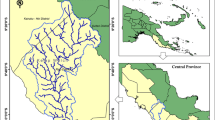Abstract
Among all natural disasters, floods in urban zones are the most harmful to humans and the economy. To engineers and city managers, making decisions and managing such risk is a tough task. To provide a reliable tool for the urban planner, mainly, to avoid construction in flood-prone areas, this paper presents a useful multicriteria decision analysis (MCDA) methodology for mapping vulnerability to flood risk in urban areas. The approach is applied to Sigus city, east of Algeria, which is considerably damaged by a flood in 1995. The proposed methodology is based on the combination of geographical information systems (GIS) and the analytical hierarchy process (AHP). To fulfill this approach, large data for Sigus city were collected. We considered four criteria that are the most influencing: distance from the main stream “C 1,” site elevation “C 2,” slope “C 3,” and land use “C 4. “Then we made the pairwise comparison between them to get the weight of each criterion. Using ArcGIS software, the criteria weights were transformed into maps and overlaid to produce a final map which is scaled by 05 levels of flood vulnerability. The results show that the criterion “C 1” is the most important. The spatial distribution of flood risk vulnerability is much more important when we approach the main stream.







Similar content being viewed by others
References
Benmena S (2000) Introduction aux méthodes multicritères d’aide à la Décision. Biotechnol Agron Soc Environ 4(2):83–93
Brunelli M (2015) Introduction to the analytic hierarchy process. SpringerBriefs in Operations Research, 88p
Chen J (2007) Rapid urbanization in China: a real challenge to soil protection and food security. Elsevier. CATENA 69(1):15
Djordjevic S, Vojinovic Z (2014) Uncertainties in flood modeling in urban areas. In: Applied uncertainty analysis for flood risk management. World Scientific, Singapore, pp 297–334
Faregh W, Benkhaled A, (2016) Détermination du ruissellement dans le bassin versant Sigus par la méthode du SCS-CN à l’aide d’un système d’information géographique. LARHYSS Journal, ISSN 1112-3680, n°27, pp 257–276, 20p
Faregh W, Benkhaled A (2018) Etude du risque hydrologique en zone urbaine, cas de le région de Oum el Bouaghi, thèse de Doctorat, université Mohamed Khider, Biskra, 281p
Fernandez P, Mourato S (2018) Social vulnerability assessment of flood risk using GIS-based multicriteria decision analysis. A case study of Vila Nova de Gaia (Portugal). Geomatics Nat Hazards Risk, 2016 7(4):13671389
Gigovic L, Pamucar D (2017) Application of GIS-Interval Rough AHP Methodology for Flood Hazard Mapping in Urban Areas. Water 9:360. https://doi.org/10.3390/w9060360
EM-DAT (2007) http://www.emdat.be.
Kang IS, Park JI, Singh VP (1998) Effect of urbanization on runoff characteristics ofthe On-Cheon Stream watershed in Pusan, Korea. Hydrol Process 12:351–363
Lawal DU, Matori AN (2012) Detecting flood susceptible areas using GIS-based analytic hierarchy process. 2012 International Conference on Future Environment and Energy IPCBEE vol.28 (2012), p 12
Malczewski J (2006) GIS-based multicriteria decision analysis: a survey of the literature. Int J Geogr Inf Sci 20(7):703–726
Mateeul H, Memon A (2012) Techniques of remote sensing and GIS for flood monitoring and damage assessment: a case study of Sindh province, Pakistan. Egypt J Remote Sens Space Sci:7
Pawattana C, Tripathi NK (2013) Analytical hierarchical process (AHP) – based flood water retention planning in Thailand. GISci Remote Sens 45(3):343–355
Pugnet L (2015) Vulnérabilité des interfaces habitat-foret _à l'aléa incendie de forêt. : Evaluation couplant dires d'experts et simulation physique d'exposition. Thèse de doctorat en géographie et aménagement, université de Nice-Sophia Antipolis, 374p
Roopnarine R, Opadeyi J (2018) GIS-based flood susceptibility and risk mapping Trinidad using weight factor modeling. Caribbean J Earth Sci 49:1–9
Saaty TL, Vargas LG, (2000) Models, methods, concepts Sc applications of the analytic hierarchy process. Springer Science + Business Media, LLC, 334p
Sahani M (2011) Le contexte urbain et cligmatique des risques hydrologiques de la ville de Butembo (Nord-Kivu /RDC). Thèse de doctorat, Université de Liège, 300p
Sauer VB, Thomas W (1984) Flood characteristics of urban watersheds in the United States. United States Geological Survey Water-Supply Paper 2207, p 69
Sinha R, Bapalu GV (2008) Flood risk analysis in the Kosi river basin, north Bihar using multi-parametric approach of Analytical Hierarchy Process (AHP). J Indian Soc Remote Sens 36(4):335–349
Soulis KX, Valiantzas JD (2012) SCS-CN parameter determination using rainfall-runoff data in heterogeneous watersheds – the two-CN system approach. Hydrol Earth Syst Sci 16(3):1001–1015
Willett K, Sharda R (1991) Using the analytic hierarchy process in water resources planning brbe: selection of flood control projects. Socio-Eco Plan Sci 25(2):103–112
Zaharia L, Costache R (2017) Mapping flood and flooding potential indices: a methodological approach to identifying areas susceptible to flood and flooding risk. Case study: the Prahova catchment. Front Earth Sci. https://doi.org/10.1007/s11707-017-0636-1
Availability of data and material
The authors confirm that the data supporting the findings of this study are available within the thesis “Study of hydrological risk in urban areas, Case of Oum El Bouaghi region” and its supplementary material.
Code availability
This study did not generate any code.
Funding
This research was supported and funded by LARHYSS laboratory.
Author information
Authors and Affiliations
Corresponding author
Ethics declarations
Conflict of interest
The authors declare no competing interests.
Additional information
Responsible Editor: Broder J. Merkel
Rights and permissions
About this article
Cite this article
Faregh, W., Benkhaled, A. GIS-based multicriteria approach for flood risk assessment in Sigus city, east Algeria. Arab J Geosci 14, 1152 (2021). https://doi.org/10.1007/s12517-021-07314-w
Received:
Accepted:
Published:
DOI: https://doi.org/10.1007/s12517-021-07314-w




